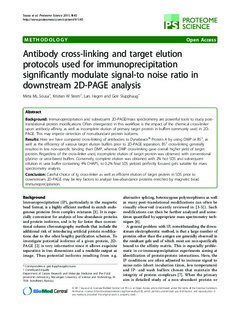| dc.contributor.author | Sousa, Mirta | |
| dc.contributor.author | Steen, Kristian Wollen | |
| dc.contributor.author | Hagen, Lars | |
| dc.contributor.author | Slupphaug, Geir | |
| dc.date.accessioned | 2019-10-10T07:59:56Z | |
| dc.date.available | 2019-10-10T07:59:56Z | |
| dc.date.created | 2011-10-24T10:44:35Z | |
| dc.date.issued | 2011 | |
| dc.identifier.citation | Proteome Science. 2011, 9 . | nb_NO |
| dc.identifier.issn | 1477-5956 | |
| dc.identifier.uri | http://hdl.handle.net/11250/2621325 | |
| dc.description.abstract | Background
Immunoprecipitation and subsequent 2D-PAGE/mass spectrometry are powerful tools to study post-translational protein modifications. Often disregarded in this workflow is the impact of the chemical cross-linker upon antibody affinity, as well as incomplete elution of primary target protein in buffers commonly used in 2D-PAGE. This may impede detection of non-abundant protein isoforms.
Results
Here we have compared cross-linking of antibodies to Dynabeads® Protein A by using DMP or BS3, as well as the efficiency of various target elution buffers prior to 2D-PAGE separation. BS3 cross-linking generally resulted in less non-specific binding than DMP, whereas DMP cross-linking gave overall higher yield of target protein. Regardless of the cross-linker used, incomplete elution of target protein was observed with conventional glycine- or urea-based buffers. Conversely, complete elution was obtained with 2% hot SDS and subsequent dilution in urea buffer containing 4% CHAPS, to 0.2% final SDS yielded perfectly focused gels suitable for mass spectrometry analysis.
Conclusion
Careful choice of Ig cross-linker as well as efficient elution of target protein in SDS prior to downstream 2D-PAGE may be key factors to analyze low-abundance proteins enriched by magnetic bead immunoprecipitation. | nb_NO |
| dc.language.iso | eng | nb_NO |
| dc.publisher | BMC (part of Springer Nature) | nb_NO |
| dc.rights | Navngivelse 4.0 Internasjonal | * |
| dc.rights.uri | http://creativecommons.org/licenses/by/4.0/deed.no | * |
| dc.title | Antibody cross-linking and target elution protocols used for immunoprecipitation significantly modulate signal-to noise ratio in downstream 2D-PAGE analysis | nb_NO |
| dc.type | Journal article | nb_NO |
| dc.type | Peer reviewed | nb_NO |
| dc.description.version | publishedVersion | nb_NO |
| dc.source.pagenumber | 8 | nb_NO |
| dc.source.volume | 9 | nb_NO |
| dc.source.journal | Proteome Science | nb_NO |
| dc.identifier.doi | 10.1186/1477-5956-9-45 | |
| dc.identifier.cristin | 847354 | |
| dc.description.localcode | © 2011 Sousa et al; licensee BioMed Central Ltd. This is an Open Access article distributed under the terms of the Creative Commons Attribution License (http://creativecommons.org/licenses/by/2.0), which permits unrestricted use, distribution, and reproduction in any medium, provided the original work is properly cited. | nb_NO |
| cristin.unitcode | 194,65,15,0 | |
| cristin.unitname | Institutt for klinisk og molekylær medisin | |
| cristin.ispublished | true | |
| cristin.fulltext | original | |
| cristin.qualitycode | 1 | |

